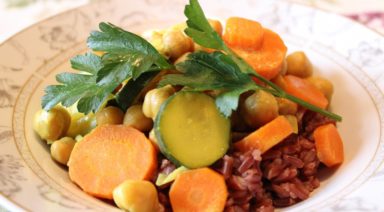Kapha Reducing Breakfast Porridge

Are you feeling a little heavy and a little sluggish? Are you craving sunshine and warmth and wish for Spring to put a spring in your step?
It’s not surprising that many people in the Northern hemisphere take off to warm and tropical destinations in February and March. At this point many of us have had enough of the cold and damp climate and are ready to “dry up and warm up” from the outside in and kick our natural Vitamin D production into a higher gear again.
If you suffer from SAD (Seasonal Affective Disorder) you may already be supplementing with additional Vitamin D and possibly even reaching for other means such as commercially available sources of full spectrum sunlight. Alternately, you may subscribe to a regular sauna practice which is helpful in driving the dampness, Kapha, out of your bones and joints and helps to release the sluggish feeling that can so easily settle on our body-mind.
Of course you can alleviate some of these Kapha traits, such as a feeling of cold and damp, sluggishness of body and mind, and a craving for sun, light, and warmth, by feeding your body the right nutrients to warm up from the inside out rather than only from outside in.
A good way to look at it is much like the stoking of a furnace. If you are living in a cool climate which sports cold and damp winters that drag well into the February and March months, you may be served well by avoiding foods that are inherently cold, such as raw fruit and salads, anything eaten right out of the fridge, ice creams and also cold water.
In Ayurveda we are trying to counter unwanted qualities with their opposite. Kapha is mainly cold and wet in nature, thus we find Kapha prominent in late Winter and early Spring when we are moving away from the dry and harsher cold and into the time of year when the earth is getting ready again for new growth. Kapha is also heavy in nature and a person with this body-type may find that their metabolism is a little sluggish and their digestion is quite slow.
Foods that can thoroughly spark your inner furnace and put a smile on your face are those that are steamed or slightly cooked, warm stews and soups that are rich in nutrients yet easy on your digestive load. Make sure to include plenty of spices such as ginger, garlic, chili or cayenne (careful if you are of Pitta constitution). Chili and cayenne also contain capsaicin which is known to have an effect similar to endorphins in your body and therefore has been noted as a natural metabolic stimulant, mood enhancer, and in some cultures as an aphrodisiac.
Here is a recipe for a delicious breakfast porridge that packs a mild punch and gives you a cozy start to your day without giving you the weighed down feeling a warm meal can otherwise give you in the morning.
The millet in this recipe has a dry quality that counters the heavy and moist quality of Kapha. The spices are mostly pungent which also works to balance Kapha, especially if you chose to add a little chili or cayenne to your porridge. Even though the sweet quality of honey has a building (or Kapha increasing effect on us) it is helpful in this recipe as raw honey has a pungent post-digestive effect, which means that it helps alleviate the Kapha and scrape it out of your cells.
Kapha Reducing Breakfast Porridge
Serves 1
Ingredients:
- 1/4 cup dry millet
- 1 small apple, the kind that’s in season
- Pinch of ground clove
- Pinch of dry ginger
- 1/2 tsp ground cinnamon
- Pinch of ground cardamom
- Pinch of ground chili – optional
- 1 cup of water
- 1 tsp raw honey
Directions:
Cook all ingredients on low heat for about 20 minutes. Check consistency and add water if you like. Add a teaspoon of raw honey just before serving.
I like to top my porridge with some toasted walnuts (toast walnut halves at 350 F for 16 minutes, let cool and use as desired).
This Kapha reducing breakfast is fixed to give you a solid start and warm you up on a cold morning, and leaves you feeling satisfied and alert for what the day holds for you without weighing you down.
Help Your Skin Glow With This Tasty Chocolate Treat Recipe

The smell of just about any chocolate is enough to get me invigorated and peppy, and so finding this healthy, yet still-delicious superfood recipe made me want to jump for joy! I definitely need a little chocolate indulgence now and then, and you probably do, too. The good news is this recipe for a tasty chocolate bark will not only get your taste buds singing, but it will also give your skin a healthy glow and your heart a healthy boost!
It’s all thanks to these stellar ingredients:
Dark Chocolate
There are so many great things dark chocolate (with the right type and in the correct proportions!) can do for us, but we’ll stick to just a few. Flavanols, which are plant compounds naturally found in the cocoa bean, help promote blood flow and dilate vessels. This action helps to deliver nutrients throughout the body, including the skin.
A study found that cocoa flavanols protect the skin from ultraviolet damage, increase blood flow to the skin, increase density and thickness of the skin, decrease water loss, and improve the overall appearance of the skin. It’s also good for your heart health; studies show that eating a small amount of dark chocolate two or three times each week can help lower your blood pressure. Dark chocolate improves blood flow and may help prevent the formation of blood clots.
Eating dark chocolate may also prevent arteriosclerosis (hardening of the arteries). It can even make you happy! Dark chocolate also contains several chemical compounds that have a positive effect on your mood and cognitive health. Chocolate contains phenylethylamine (PEA), the same chemical your brain creates when you feel like you’re falling in love (this explains so much). PEA encourages your brain to release endorphins.
It’s also got several important vitamins and minerals:
- Potassium
- Copper
- Magnesium
- Iron
Chia Seeds
We’ve covered chia seeds before as a trendy health food, but there’s a lot to this seed’s story. There is a lot of buzz around chia’s weight loss power. Chia’s stabilizing effect on blood sugar also fights insulin resistance which can be tied to an increase in belly fat. This type of resistance can also be harmful to your overall health. Chia seeds are packed with soluble fiber and are high in antioxidants, calcium, iron, manganese, and phosphorous.
A unique property of chia seeds is the ability to hold up to 12 times its weight in water. Soaked for 30 mins, the seeds will form a gel-like substance. Researches believe this gel reaction also occurs in the stomach, forming a barrier, which means carbohydrates are broken down slowly. This makes the seeds popular among endurance athletes and also diabetics, who want a slow-release energy source, as well as for extra hydration.
Good Fatty Nuts
Nuts are a great source of healthy, unsaturated fats. It’s thought that the “good” fats in nuts — both monounsaturated and polyunsaturated fats — lower bad cholesterol levels. They also have omega-3 fatty acids in abundance, which are a healthy form of fatty acids that seem to help your heart by, among other things, preventing dangerous heart rhythms that can lead to heart attacks. Omega-3 fatty acids are also found in many kinds of fish, but nuts are one of the best plant-based sources of omega-3 fatty acids. All nuts also contain fiber, which helps lower your cholesterol, help you feel fuller, and is thought to play a role in preventing diabetes. Add in nuts’ supply of Vitamin E, plant sterols, and l-arginine, and your heart will stay pumping at maximum efficiency!
Ingredients
- 10 ounces 70% cocoa bittersweet dark chocolate
- 2 teaspoons instant espresso powder
- ½ cup toasted walnut pieces
- ½ cup toasted pecan pieces
- ½ cup toasted almond slices
- 1 tablespoon chia seeds
Directions:
- Combine chocolate and coffee, place over a double boiler, heating on a low flame while stirring until chocolate is 3/4 melted.
- Remove from heat and stir until smooth.
- Mix in the toasted nuts and chia seeds.
- Spread mixture on a sheet pan lined with parchment paper and chill until mixture sets, about 30 minutes.
- Break into pieces and serve. Enjoy!





































